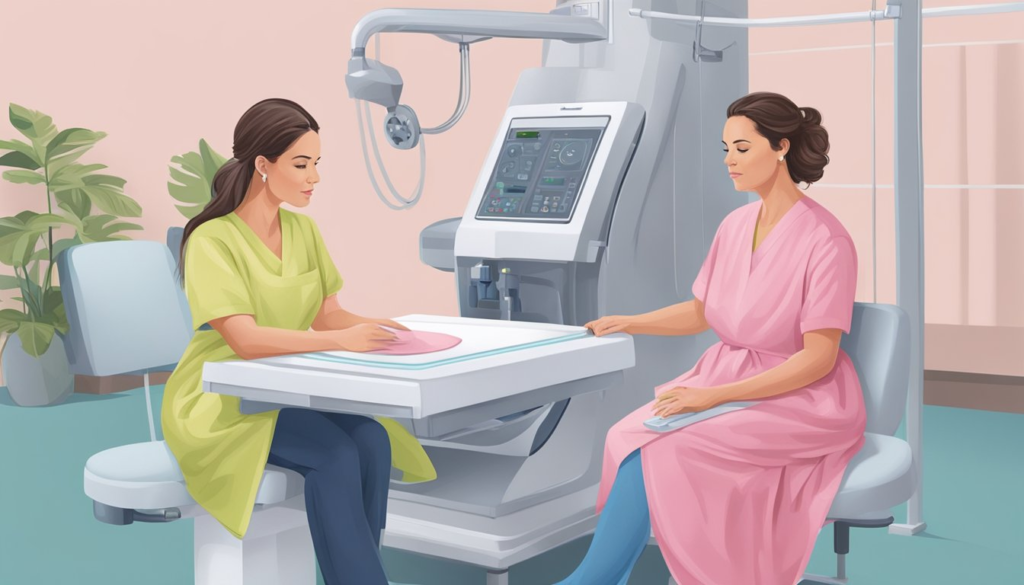Breast health is an essential aspect of overall well-being for women, and staying proactive about it can lead to early detection and better outcomes in cases of breast cancer. Regular self-examinations, mammograms, and an understanding of personal risk factors play crucial roles in maintaining breast health.
This article explores the importance of breast self-exams, mammograms, and awareness of breast cancer risk factors to empower women to take charge of their health.
Breast Self-Exams: Early Detection at Home
A breast self-exam is a simple, regular practice that allows women to become familiar with their breasts and detect any unusual changes early. Performing self-exams helps women recognize the natural texture and appearance of their breasts so that they can notice any new lumps, thickening, or changes in skin texture.
How to Perform a Breast Self-Exam:
- Visual Inspection: Stand in front of a mirror with your arms at your sides and then with your arms raised. Look for changes in size, shape, or skin texture (dimpling, puckering) and check for any nipple discharge.
- Lying Down: Lie down and use your right hand to feel your left breast and your left hand to feel your right breast. Use the pads of your fingers and move in a circular motion from the outer part of the breast toward the center. Be sure to check the entire breast, armpit area, and collarbone.
- Shower Check: Some women find it easier to do a self-exam in the shower when the skin is wet. Use a similar circular motion to feel for lumps or thickening under the skin.
What to Look For:
- Lumps or Masses: Not all lumps are cancerous, but any new or unusual lump should be checked by a healthcare provider.
- Changes in Size or Shape: Significant changes in the size or shape of one or both breasts may be a cause for concern.
- Skin Texture: Dimpling, puckering, or thickening of the skin may indicate underlying issues.
- Nipple Changes: Look for inverted nipples, redness, or nipple discharge.
While breast self-exams are not a substitute for professional screening, they are an important first step in detecting potential breast abnormalities.
Mammograms: A Key Screening Tool
A mammogram is an X-ray of the breast that can detect cancer at an early stage, often before a lump can be felt. Regular mammograms are critical in reducing breast cancer mortality, as early detection significantly improves treatment success rates.
When to Get a Mammogram:
- Women aged 40 to 44: Should discuss the option of annual mammograms with their healthcare provider.
- Women aged 45 to 54: Should have mammograms annually.
- Women aged 55 and older: Can switch to mammograms every two years or continue annual screenings, depending on their risk factors.
What Happens During a Mammogram:
During a mammogram, each breast is compressed between two plates to spread the tissue and get clear X-ray images. The process takes only a few minutes and may cause some discomfort, but it provides detailed images that help detect small changes or lumps in the breast tissue.
Types of Mammograms:
- Screening Mammogram: Performed routinely on women with no symptoms to detect any early signs of breast cancer.
- Diagnostic Mammogram: Used to investigate suspicious breast changes, such as a lump or unusual imaging from a screening mammogram.
Mammograms are considered one of the most effective tools for detecting breast cancer early, even before symptoms appear.
Breast Cancer Risk Factors: What You Need to Know
Understanding breast cancer risk factors is essential for making informed decisions about your health. While some risk factors cannot be changed, others are lifestyle-related and can be modified to reduce the likelihood of developing breast cancer.
Non-Modifiable Risk Factors:
- Age: The risk of breast cancer increases with age, with most cases diagnosed in women over 50.
- Genetics: Women who inherit certain genetic mutations, such as BRCA1 and BRCA2, have a higher risk of breast cancer. Family history of breast or ovarian cancer also increases risk.
- Reproductive History: Women who started menstruating early (before age 12) or went through menopause late (after age 55) are exposed to estrogen for a longer period, increasing the risk of breast cancer.
- Personal History of Breast Cancer: Women who have had breast cancer before are at an increased risk of developing it again.
Modifiable Risk Factors:
- Lifestyle Factors: Maintaining a healthy weight, regular exercise, limiting alcohol consumption, and avoiding smoking can reduce breast cancer risk.
- Hormone Replacement Therapy (HRT): Long-term use of HRT for menopause symptoms may increase the risk of breast cancer. Women should consult their healthcare provider about the benefits and risks of HRT.
- Breastfeeding: Women who breastfeed, especially for more than one year, may have a slightly reduced risk of breast cancer.
Genetic Testing:
Women with a strong family history of breast or ovarian cancer may consider genetic testing for BRCA1 or BRCA2 mutations. Those with these mutations may opt for increased screening or preventive measures, such as prophylactic mastectomy or medication.
Breast Health Awareness: Key Takeaways
- Stay Informed: Regularly perform self-exams and get to know your body. The earlier you detect changes, the sooner you can seek medical advice.
- Get Screened: Follow recommended guidelines for mammograms based on your age and risk factors. Early detection through mammography saves lives.
- Understand Your Risk: Be aware of your personal risk factors for breast cancer, including family history, lifestyle, and genetic predispositions.
- Make Healthy Choices: Maintain a healthy lifestyle by exercising, eating a balanced diet, and avoiding harmful habits like smoking or excessive alcohol consumption.
Being proactive about breast health is crucial in reducing the risk of breast cancer and ensuring early detection, which leads to better treatment outcomes.
Conclusion
Breast health is an essential part of overall wellness, and by staying informed about self-exams, mammograms, and risk factors, women can take control of their health. Regular screenings and healthy lifestyle choices are key to preventing breast cancer and detecting it early when it is most treatable.
Frequently Asked Questions (FAQ)
How often should I perform a breast self-exam?
It is recommended to perform a breast self-exam once a month, ideally a few days after your menstrual period when your breasts are less tender. For women who have gone through menopause, choose the same day each month to perform the self-exam.
At what age should I start getting mammograms?
Women should begin discussing mammograms with their healthcare provider in their 40s. Most guidelines recommend annual mammograms starting at age 45, but women at higher risk may need to start earlier.
What should I do if I find a lump during a breast self-exam?
If you find a lump or any other changes during a self-exam, contact your healthcare provider for an evaluation. Not all lumps are cancerous, but it’s important to get checked to rule out any serious conditions.
Can men get breast cancer?
Yes, although breast cancer is much more common in women, men can also develop breast cancer. It’s important for men to be aware of their breast health and report any unusual changes to a healthcare provider.
What lifestyle changes can lower my risk of breast cancer?
Maintaining a healthy weight, staying physically active, limiting alcohol intake, avoiding smoking, and breastfeeding if possible can help reduce the risk of breast cancer. Regular screenings and awareness of personal risk factors are also important.



